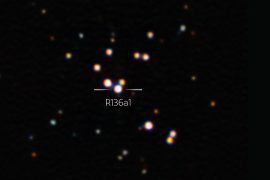
Many supermassive black holes hurl matter into space. Now, for the first time, researchers have succeeded in recording the region around a black hole and its jet of matter at the same time.
Bonn – Black holes are mysterious celestial bodies. His incredible gravity pulls everything that comes near him. The matter orbits around an active black hole on a so-called accretion disk, heats up, glows and is slowly swallowed by the monstrous celestial body. Some black holes also emit a so-called jet into space – a stream of matter that moves at almost the speed of light.
How black holes create these jets, which extend far beyond their own galaxy, remains a mystery. “We know that jets shoot out from regions around black holes,” says Ru-Sen Lu of the Shanghai Astronomical Observatory in China. Communications, “But we still don’t fully understand how exactly this happens. For direct study, we need to observe the origin of the jet as close as possible to the black hole.”
Black hole M87* ejects a stream of matter into space
A new recording can now help researchers track down the phenomenon. A research group has used the Global Millimeter VLBI Array (GMVA) – an array of radio telescopes that combine to form an Earth-spanning telescope – to photograph the black hole M87* and its jet. M87* is about 55 million light-years from Earth and 6.5 billion times more massive than our Sun. Like most supermassive black holes, it is located at the center of a galaxy. M87* may be one of the best-known black holes, as it is the specimen from which the first black hole picture was published in 2019.

The 2019 image shows the region around the black hole, including its shadow on the accretion disk. The new image shows even more: not only can the region around the black hole be seen, but also the jet emitted by M87*. “This new image completes the picture by showing the region around the black hole and the jet at the same time,” says Jae-Young Kim from the Max Planck Institute for Radio Astronomy (MPIFR) in Bonn.
Scientists study black holes in new images
“The large and thick ring we see now can be explained by gas collapsing into the black hole,” Lu explains of the image. “The observed radiation allows a better understanding of the physical processes in the immediate vicinity of the black hole and the interplay between accretion and jet generation,” he says. The method used to take the picture is not new: long baseline interferometry (VLBI) was used to link together several large radio telescopes around the world to form one large, Earth-spanning telescope. The first picture of a black hole was also taken with this technique.
“With the much improved imaging capabilities of the GMVA, we are gaining new insights into the physical processes involved in jet generation,” says Thomas Krichbaum of MPIFR. Communications, You can see jets coming out of the emission ring around the black hole. research work in the magazine Nature published,
Recently, researchers have Black hole with more than 30 billion solar masses like that oldest known black hole got to know. (tab)

Internet fan. Alcohol expert. Beer ninja. Organizer. Certified tv specialist. Explorer. Social media nerd.



